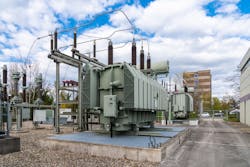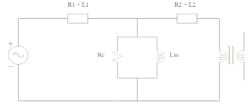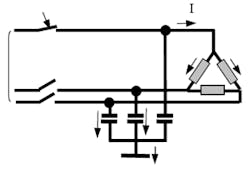When I start talking about ferroresonance, either eyes glaze over or people believe it is part of the flux capacitor in that 1981 DeLorean from that movie we all love. What is ferroresonance in power systems, besides a word that’s hard to spell?
Ferroresonance is a complex electrical phenomenon that, though identified in the early 1920s, remains little understood today. It is characterized by the sudden onset of very high sustained overvoltages along with high levels of harmonic distortion. Ferroresonance has been known to be responsible for equipment damage and equipment protection malfunctions.
Ferroresonance is in principle a series resonance with a capacitor and a nonlinear inductance that involves a saturable magnetizing inductance. The phenomenon preferably occurs in the absence of appropriate damping. In a power system that inductance typically consists of the magnetizing inductances of power transformers and the series capacitances of occurring capacitances in the distribution network.
On a typical electric utility distribution or industrial plant medium-voltage circuit, ferroresonance occurs most frequently when all of the following conditions are in place:
- A circuit with both capacitance and inductance is present. A capacitor bank serves as the capacitance, while the iron core and copper coil of an energized transformer can serve as the inductance.
- Low resistance is present in the circuit. This can be in the form of a lightly loaded piece of power system equipment (e.g., unloaded power transformer) or short sections of line.
- The existence of at least one point in the system whose potential (i.e., voltage level) is not fixed. This can be an isolated neutral or can be created by a blown fuse or during single-phase switching. This one “degree of freedom” can allow the system to “reposition” itself into a ferroresonance condition.
The most common occurrence of ferroresonance in electric utility power systems is on grounded systems having lightly loaded (or unloaded) transformers with ungrounded-wye or delta-connected primaries, where single-pole switching leaves phase-to-phase or phase-to-ground capacitance connected to the load side of the switch. The maximum value of the switching surge that can occur during this condition can be between two to five times the normal system voltage, which can cause significant equipment damage.
In this customer substation example, there is a delta-connected transformer. When the transformer is energized, there is a high amount of exciting current that flows for a short time to energize the magnetic core of the transformer and create the magnetic flux in the core that allows the transformer to function. This magnetizing inrush current can be on the order of 10 times the normal load current, but exists for a very short time (less than 0.1 seconds in most cases), per ANSI/IEEE C57.12 and C57.109.
However, when there is a capacitor in series or parallel with the transformer when energization occurs, this resonant condition may occur, which can cause the high current to persist for longer periods. This high excitation current persisted at this customer location because of the low circuit resistance (i.e., no load on transformers), as it would otherwise be damped out more quickly with more resistance. High currents lead to higher than nominal voltages, which can cause equipment damage and flashovers of lightning arresters (above the maximum overvoltage MOV of the arrester).
Ferroresonance can be worsened by poor system grounding — through either ineffective ground connections or high soil resistivity. The high voltage created on the primary system during the resonance could cause a rise in ground potential, which would have subjected sensitive equipment to voltages that could have exceeded insulation levels.
There are several ways to minimize ferroresonance in power systems. These include:
- Perform only 3-phase switching of capacitor banks as opposed to single-phase switching.
- Use switching devices that are not susceptible to prestriking and/or restriking arcs. Distribution fused cutouts are notorious for restriking when opened slowly.
- The use of grounded-wye transformer connections instead of delta-connected primaries.
- Grounding the neutral of wye-connected primaries and having an effectively grounded power system.
- Not energizing capacitors and transformers at the same time.
- Not re-energizing capacitor banks within five minutes of being de-energized. Utility capacitor banks contain draining resistors to slowly discharge the stored capacitive energy.
David Colombo, P.E. is a professional engineer located in Massachusetts, and the owner and principal of Power Engineers, LLC, a design, engineering, and consulting firm. He has more than 30 years in the electrical engineering and construction industry and is involved with the design of utility substation & distribution infrastructure, large-scale renewable energy projects, and commercial / industrial power systems. He specializes in the areas of medium-voltage design, power distribution, protection, metering, power quality, power studies, and arc flash analysis. He also provides owner’s engineering support for developers, EPC contractors, and project owners. Prior to starting Power Engineers, LLC and being an engineering consultant, he was a utility distribution supervising engineer. He holds a bachelor of science degree in electrical engineering from Worcester Polytechnic Institute (WPI) and a master of engineering degree in electric power engineering from Rensselaer Polytechnic Institute (RPI). He is a registered professional engineer in 13 states.
About the Author

David Colombo
David Colombo, P.E. is a Professional Engineer located in Massachusetts, and the owner and principal of Power Engineers, LLC, a design, engineering and consulting firm. He has over 30 years in the electrical engineering and construction industry and is involved with the design of utility substation & distribution infrastructure, large scale renewable energy projects, and commercial / industrial power systems. He specializes in the areas of medium-voltage design, power distribution, protection, metering, power quality, power studies and, arc flash analysis. He also provides owner’s engineering support for developers, EPC contractors and project owners. Prior to starting Power Engineers, LLC and being an engineering consultant, he was a utility distribution supervising engineer. He holds a Bachelor of Science degree in Electrical Engineering from Worcester Polytechnic Institute (WPI) and a Master of Engineering degree in Electric Power Engineering from Rensselaer Polytechnic Institute (RPI). He is a Registered Professional Engineer in 13 states.


